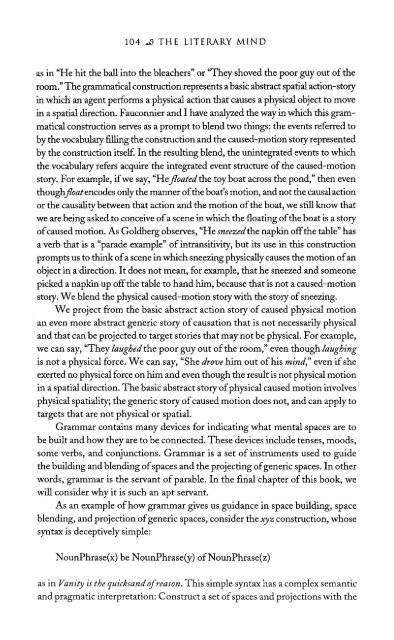The Literary Mind.pdf
The Literary Mind.pdf
The Literary Mind.pdf
Create successful ePaper yourself
Turn your PDF publications into a flip-book with our unique Google optimized e-Paper software.
104 THE LITERARY MIND<br />
as in "He hit the ball into the bleachers" or "<strong>The</strong>y shoved the poor guy out of the<br />
room." <strong>The</strong> grammatical construction represents a basic abstract spatial action-story<br />
in which an agent performs a physical action that causes a physical object to move<br />
in a spatial direction. Fauconnier and I have analyzed the way in which this grammatical<br />
construction serves as a prompt to blend two things: the events referred to<br />
by the vocabulary filling the construction and the caused-motion story represented<br />
by the construction itself. In the resulting blend, the unintegrated events to which<br />
the vocabulary refers acquire the integrated event structure of the caused-motion<br />
story. For example, if we say, "He floated the toy boat across the pond," then even<br />
though floaf encodes only the manner of the boat's motion, and not the causal action<br />
or the causality between that action and the motion of the boat, we still know that<br />
we are being asked to conceive of a scene in which the floating of the boat is a story<br />
of caused motion. As Goldberg observes, "He sneezed the napkin off the table" has<br />
a verb that is a "parade example" of intransitivity, but its use in this construction<br />
prompts us to think of a scene in which sneezing physically causes the motion of an<br />
object in a direction. It does not mean, for example, that he sneezed and someone<br />
picked a napkin up off the table to hand him, because that is not a caused-motion<br />
story. We blend the physical caused-motion story with the story of sneezing.<br />
We project from the basic abstract action story of caused physical motion<br />
an even more abstract generic story of causation that is not necessarily physical<br />
and that can be projected to target stories that may not be physical. For example,<br />
we can say, "<strong>The</strong>y laughed the poor guy out of the room," even though laughing<br />
is not a physical force. We can say, "She drove him out of his mind" even if she<br />
exerted no physical force on him and even though the result is not physical motion<br />
in a spatial direction. <strong>The</strong> basic abstract story of physical caused motion involves<br />
physical spatiality; the generic story of caused motion does not, and can apply to<br />
targets that are not physical or spatial.<br />
Grammar contains many devices for indicating what mental spaces are to<br />
be built and how they are to be connected. <strong>The</strong>se devices include tenses, moods,<br />
some verbs, and conjunctions. Grammar is a set of instruments used to guide<br />
the building and blending of spaces and the projecting of generic spaces. In other<br />
words, grammar is the servant of parable. In the final chapter of this book, we<br />
will consider why it is such an apt servant.<br />
As an example of how grammar gives us guidance in space building, space<br />
blending, and projection of generic spaces, consider the xyz construction, whose<br />
syntax is deceptively simple:<br />
NounPhrase(x) be NounPhrase(y) of NounPhrase(z)<br />
as in Vanity is the quicksand of reason. This simple syntax has a complex semantic<br />
and pragmatic interpretation: Construct a set of spaces and projections with the















